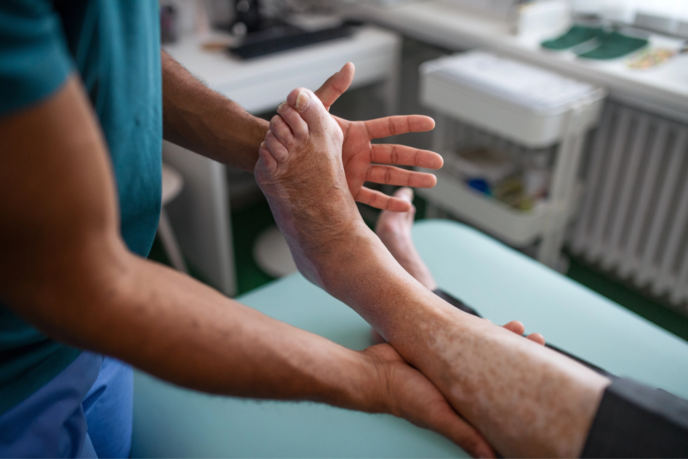
What is Dialysis Access Management
Noam Spinowitz, MD, is an interventional nephrologist specializing in the maintenance and management of vascular accesses for dialysis patients. Patients from across the tri-state area seek him out for his expertise. He frequently performs advanced techniques to salvage accesses that other providers have been unable to care for. He has also pioneered treatments for access maturation and for dialysis access steal syndrome, relieving hand pain related to dialysis access. In this article, Dr. Spinowitz discusses the process of dialysis access management.
What is Dialysis Access Management?
The dialysis access, as we explained before, could be either fistula, graft, or catheter, whether it’s hemodialysis catheter or peritoneal dialysis catheter. All of these accesses are unnatural.
The body does not want to have an artery attached to a vein, it does not want to have an external foreign body introduced into the vein or into the peritoneal cavity. Because everything is unnatural, the body in a way tries to fight what’s going on. The body will react with either scar tissue or narrowing, if it gets irritated, or inflamed, this will all cause dysfunction for the access.
Every other day at dialysis, the patient presents to the dialysis unit and their access, whether it’s a fistula or a graft, will be cannulated, in a way damaging the fistula and the graft. Even if everything was to go well and the veins and arteries are all open, there is still some damage from cannulation that can occur for each patient, and we need to manage and maintain this access.
We make sure that the flow from the artery (from the arterial tree) into the fistula (across the anastomosis, the connection between the artery and the vein) is all open and running well.
In order for a patient to receive adequate dialysis, they need a certain amount of blood flow and the fistula or graft to be a certain size to put the needle into the body. The pathway from the fistula back to the heart also needs to be wide open to allow for easy flow back to the heart and decreased pressure within the system. In order to ensure adequate flow through the system, one needs to maintain this access.
How Does Dialysis Access Work?
The job of the kidney is to filter the blood, removing wastes, toxins, extra fluid, and maintaining the balance of electrolytes. When the kidney is not functioning normally, fluids can build up, toxins can build up, and electrolytes can be abnormal, which can be deadly. When the kidney, for whatever reason is not functioning normally, the body needs to remove those wastes, get rid of those fluids, and maintain electrolyte balance another way. Therefore, we need dialysis. There are different modalities for dialysis, including hemodialysis and peritoneal dialysis.
Hemodialysis can be performed through a fistula, a graft, or a catheter. The blood is removed from the body and brought through a machine. That machine acts like the kidney, removing the extra fluids and waste, maintaining electrolyte balance, and returning clean blood to the body.
Peritoneal dialysis is similar in that the body is able to be cleaned of those extra toxins, get rid of the extra fluid, and maintain electrolyte balance. However, with peritoneal dialysis, the blood is not removed from the body, cleaning the blood in the machine; rather the body is used as the machine. The peritoneal dialysis catheter is inserted into the abdomen, and the blood from the intestines–running through its normal path–is cleaned as dialysate, a fluid, and introduced into the abdomen through the peritoneal dialysis catheter.
It’s extremely dangerous for a diabetic to have a foot wound. Don’t wait. Diabetic foot wounds have a tendency to develop quickly and to rapidly worsen. This can lead to progressive gangrene and amputation if not identified and treated. If you’re a diabetic with a foot wound that hasn’t healed in one week or has been there for a long time and it’s not showing any signs of progression or improvement, you must see a podiatrist immediately and insist that you see a vascular specialist.
What are the Different Dialysis Access Procedures that are Performed by American Endovascular
I’d like to start from the beginning of the dialysis treatment for a patient.
If a patient is requiring dialysis and they do not yet have a fistula or a graft, they may require a hemodialysis catheter or a peritoneal dialysis catheter. The hemodialysis catheter is placed in the internal jugular vein, thereby allowing for adequate flow into the dialysis machine to clean the blood. Another possibility is for a peritoneal dialysis catheter to be placed.
A peritoneal dialysis catheter is placed into the abdomen, allowing dialysate which is a fluid which is allowed to enter the abdominal cavity acting like a sponge, removing the extra fluid and waste and toxins and retaining electrolyte balance through the fluid rather than through a hemodialysis machine, removing the blood from the patient.
The more common types of dialysis access include fistulas and grafts. A fistula or a graft can be created at our offices.
A fistula is a connection between the patient’s artery and the patient’s vein. This is the more natural of the two kinds of dialysis access as the patient does not have any foreign body introduced. This is a connection between the patient’s own artery and vein, although this is still unnatural for the body.
If the patient does not have a suitable vein for a fistula, a graft can be inserted. A graft is an artificial tube which is connected to the artery on one side and to the vein on the other, to allow for dialysis.
A fistula is only considered mature once there is enough flow into the fistula. The fistula is of adequate size to avoid difficulties with cannulation, and there is sufficient venous outflow back to the central venous circulation to avoid high-pressure systems.
During the maturation process, each part of the system needs to be addressed. For example, we address the arterial inflow, whether it’s the artery or the connection, and the arterial anastomosis between the artery and the vein. If that needs to be made larger, we can use angioplasty. If there is not enough flow into the main body of the fistula there may be small veins called collateral vessels draining the blood away from the main body of the fistula. Those collateral vessels can either be ligated, which means to be tied off, or undergo coil embolization, which is to put a small metal thread into those small collateral vessels, ensuring all of the flow coming from the artery stays within the main body of the fistula.
After that point, the vein needs to be able to be drained back toward the central circulation, and that is where we may use angioplasty or stent placement, or flow re-routing, which means to make a new path toward the central circulation. Ultimately we restore adequate flow from the artery, through the fistula, and back to the heart enabling clearance and cleaning of the blood for dialysis.
What are Some Complications that Can Occur to a Dialysis Access Patient?
After the fistula or graft is up and running, it will, in most cases, require maintenance. The scar tissue or narrowing that caused many of the difficulties, to begin with, doesn’t just go away after one angioplasty or a stent. Sometimes the narrowing will return. The unnatural state is there 24/7. Every time the heartbeats, it’s running through the vein or the graft, which is not how nature intended.
The scar tissue can build up, sometimes between three and six months, causing difficulties at dialysis. Some of the difficulties can lead to high-pressure complications. Some complications can arise with cannulation when you’re trying to stick an access to the fistula or graft. Other complications can include prolonged bleeding when they remove the needle from the access.
If there is high pressure, the blood will come out of that hole from the dialysis needle. We have to make sure that there is decreased pressure and avoid this bleeding complication. Other difficulties and pain for the patient can come from this high pressure causing poor healing or ulceration at the cannulation site. Some of the more central narrowing can cause swelling and cramping for the patient. If the narrowing within the arterial inflow or the venous outflow is severe, there may not be enough flow through the fistula or graft, and the graft can clot. The patient would be referred for a thrombectomy, which is a procedure to remove the clot and to repair the cause of the thrombosis.
Another complication can be something called steal syndrome, where the access is stealing blood away from the hand. If there is too much flow coming into the access, there is not enough flow going down to the hand.
This would cause numbness, stiffness, and cramping for the patient. In order to remedy that problem, we would actually make the inflow a little smaller. So just after the connection between the artery and the vein or the artery and the graft, we would make that area a little smaller, decreasing the amount of flow into the access and improving blood flow down to the hand. When there is steal syndrome, the patient would benefit from a banding procedure where we would decrease the amount of flow into the access and improve flow down to the hand, improving their symptoms. These are just some of the dialysis access procedures that are performed here at American Endovascular.
Why Choose American Endovascular for Dialysis Access Management?
take pride in education and the personalized treatment for every single person that walks through the door. I realize that with the dialysis patient, the best care is going to be with open lines of communication, not just between myself and the patient, but with the dialysis team. That includes the physician, the dialysis nurses, the techs, and everyone who is involved in taking care of that patient and their dialysis access.
Request an Appointment with Dr. Spinowitz
If you need dialysis access management, please request an appointment with Dr. Spinowitz at Harlem Endovascular today.
Related Blogs & Videos
Learn more about vascular health, prevention, and care for Peripheral Artery Disease.




